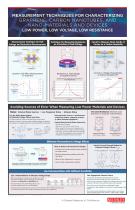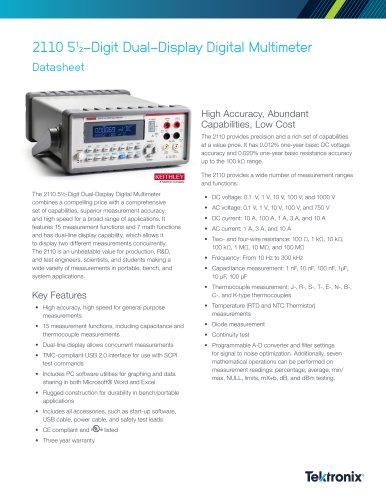
Measurement Techniques for Characterizing Graphene, Carbon Nanotubes, and Nano-Materials and Devices
1 /
1Páginas
Excertos do catálogo

MEASUREMENT TECHNIQUES FOR CHARACTERIZING GRAPHENE, CARBON NANOTUBES, AND NANO-MATERIALS AND DEVICES LOW POWER, LOW VOLTAGE, LOW RESISTANCE Measurement Technique for Hall Voltage and Resistivity Measurements Nanovoltmeter Vxy = Transversal Voltage, Hall Voltage with applied B Technique for Measuring Resistance as a Function of Gate Voltage Circuit to Measure Drain Family of Curves on a Carbon Nanotube Ground Unit or SMU3 (if required) Quantum Hall Effect Measurements on Graphene Current vs. Voltage Characteristics of Carbon Nanotube FET Resistance vs. Gate Voltage of Graphene Device Longitudinal Resistance of a Graphene Layer on a Silicon Substrate as a Function of Substrate Voltage 25000 23000 Vsubstrate (volts) Avoiding Sources of Error When Measuring Low Power Materials and Devices Noise: External Noise Sources • Low Frequency Noise • Johnson Noise Use the Delta Mode Method to Eliminate Voltage Offsets and Noise The Delta method consists of alternating the current source • External Noise Sources = interferences created by motors, computer screens, or other electrical equipment polarity and using a moving average of voltage readings to calculate the resistance. Averaging reduces the noise bandwidth and therefore Test Lead Resistance: Eliminate Lead Resistance by Using the 4-Wire Method • Control these External Noise Sources by: δV = linearly changing thermoelectric voltages ––Shielding and filtering. ––Remove or turn-off the noise source. ––When using DC instruments, integrate each measurement for an integer number of power line cycles. The line cycle noise will “average out” when the integration time is equal to an integration number of power line cycles. Measured Resistance: V M/I = RSample + 2RLead Measured Resistance: VM/I = R Sample Eliminate Thermoelectric Voltage Effects Voltmeter Copper Test Leads Metal A Copper Test Leads Metal A • Construct test circuits using the same materials for interconnects. Use the Current Reversal Method to Eliminate Voltage Offsets (VEMF ) Ways to Reduce Thermoelectric Voltages Measurement with Positive Polarity • Minimize temperature gradients within the test circuit. Measurement with Negative Polarity • Allow the test equipment to warm up. Current Source Temperature Gradient Thermoelectric voltages are generated when dissimilar metals (Metal A and Metal B) in the circuit are at different temperatures (T1 and T2). • Use an offset compensation method. Voltage Measurement: Use Instrumentation with Sufficient Sensitivity Use Appropriate Current Source Use a Nanovoltmeter to Measure Voltage Drops • Current source should be bipolar to perform current reversals to eliminate voltage offsets and reduce noise. • When measuring the resistances of conductors or other low power materials, very small voltages are measured, typically in the microvolt and nanovolt range. • Current source should be capable of accurately sourcing very low currents (<1E-6A) for low level test devices and materials. • To measure these very small voltage drops, use a sensitive voltmeter such as a nanovoltmeter. • Verify the product specifications to make sure the measurement resolution and accuracy are sufficient to perform the sensitive measurement part of your application. • The current source should have an adjustable voltage compliance to limit voltage to a safe level to avoid damage to the device. • The current source should have constant output so user knows the exact value forced to the material – unlike using a voltage source and a resistor. © Copyright 2011 Keithley Instruments, Inc. A Greater Measure of Confidence
Abrir o catálogo na página 1Todos os catálogos e folhetos técnicos Keithley Instruments
-
6220-6221
5 Páginas
-
6482
3 Páginas
-
2520
8 Páginas
-
2606B
13 Páginas
-
2601B
20 Páginas
-
AFG1000 Series
13 Páginas
-
AFG31000 Series Datasheet
22 Páginas
-
2182A Nanovoltmeter
6 Páginas
-
6 Series B MSO
69 Páginas
-
Isolated Measurement Systems
8 Páginas
-
TBS1000B-EDU Series
14 Páginas
-
3 Series MDO
36 Páginas
-
4 Series MSO
40 Páginas
-
TSG4100A Series
24 Páginas
-
2461-EC Graphical Potentiostat
16 Páginas
-
2460-EC Graphical Potentiostats
15 Páginas
-
2450-EC Graphical Potentiostat
15 Páginas
-
4200A-SCS Parameter Analyzer
45 Páginas
-
S540 Power Semiconductor Test System
11 Páginas
-
6514 Programmable Electrometer
4 Páginas
-
2460 SourceMeter ® SMU Instrument
14 Páginas
-
MDO4000C Series Datasheet
43 Páginas
-
RTPA2A
6 Páginas
-
TPA-N-PRE Datasheet
4 Páginas
-
DPO4PWR·MDO3PWR Datasheet
6 Páginas
-
DPO4LMT/MDO3LMT Datasheet
6 Páginas
-
DPO7000 Series Datasheet
28 Páginas
-
SourceXpress® Datasheet
4 Páginas
-
10G-KR Datasheet
8 Páginas
-
DPO70000SX Series Datasheet
46 Páginas
-
AWG4000 Series Datasheet
20 Páginas
-
TLA6400 Series Datasheet
14 Páginas
-
Potentiostats 2450-EC
8 Páginas
-
Series 2268 850W DC Power Supplies
6 Páginas
-
6487 Picoammeter/ Voltage Source
4 Páginas
-
6½-Digit USB Digital Multimeter
4 Páginas
-
7½-Digit Graphical Sampling Multimeter
18 Páginas
-
4200-SCS
16 Páginas
-
Model 2750 Multimeter/Switch System
1 Páginas
-
Model 2450 SMU product brochure
7 Páginas
-
2013 Keithley product catalog
403 Páginas
-
Nanotechnology Measurement
13 Páginas
-
Semiconductor Device Test
11 Páginas
-
Series 2400 SourceMeter®Family
16 Páginas
-
USB-Based Data Acquisition Modules
7 Páginas
Catálogos arquivados
-
8 Series Sampling Oscilloscope
14 Páginas
-
Multimeter/Switch System
1 Páginas
-
Keithley’s SourceMeter® Solutions
2 Páginas






































































































































